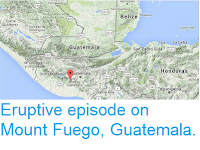Sixty two people have now been confirmed dead and many more are missing following a sudden eruption on the volcano on Sunday 3 June 2018 that produced an ash column 10 km high and sent a series of pyroclastic flows (avalanches of hot rock, ash and gas) down the flanks of the mountain scouring local communities. Ashfalls have been reported up to 20 km from the volcano, and over 3000 people have been evacuated from the area. Rescue workers have yet to reach communities that were closest to the caldera of the volcano, where drone footage shows no buildings standing and what appears to be large numbers of bodies. The eruption is now considered to have ended, but vulcanonogists are very concerned about the large amounts of loose ash that have been deposited by it, that could be dislodged by any future eruption, or mix with rain to form lahars - ash-laden flash floods associated with volcanoes, that can be caused
directly by volcanic eruptions, for example when hot lava encounters a
glacial lake rapidly destroying an ice dam, but are also common in areas
of high seasonal rainfall, where ash deposits from a volcano can build
up during the dry season, creating dams on seasonal waterways, which
temporarily halt the flow of water, then give way rapidly leading to
dramatic flash floods.
The community of San Miguel Las Lotes on Monday 4 June 2018, the day after it was hit by a pyroclastic flow from Mount Fuego. Luis Echeverria/Reuters.
Mount Fuego is a 3763 m stratovolcano (cone shaped volcano made up of layers of ash and lava)
that forms part of La Horqueta volcanic complex in the southern part of Guatemala, which has been more-or-less constantly active at some level since records in
the area began (circa 1524). It forms part of La Horqueta volcanic
complex, which also includes the Acatenango volcano to the north, a
complex volcano with at least five separate vents, the complex siting on
the site of the ancient Meseta volcano, which is thought to have
collapsed following a major volcanic episode about 8500 years ago,
causing a debris flow that reached the sea, 50 km away.
The approximate location of Mount Fuego. Google Maps.
The
volcanoes of Guatemala, and Central America in general, are fed by the
subduction of the Cocos Plate beneath the Caribbean Plate along the
Middle American Trench, which runs roughly parallel to the southwest
coast of the isthmus. As the Cocos Plate sinks into the Earth, it passes
under Central America, which lies on the western margin of the
Caribbean Plate. As this happens it is heated by the friction and the
heat of the planet's interior, causing the sinking plate to partially
melt. Some of the melted material then rises through the overlying
Caribbean Plate as magma, fuelling the volcanoes of Central America.
Diagrammatic representation of the subduction of the Cocos Plate beneath the Caribbean Plate along the Middle American Trench. VCS Mining.
See also...
Follow Sciency Thoughts on Facebook.









